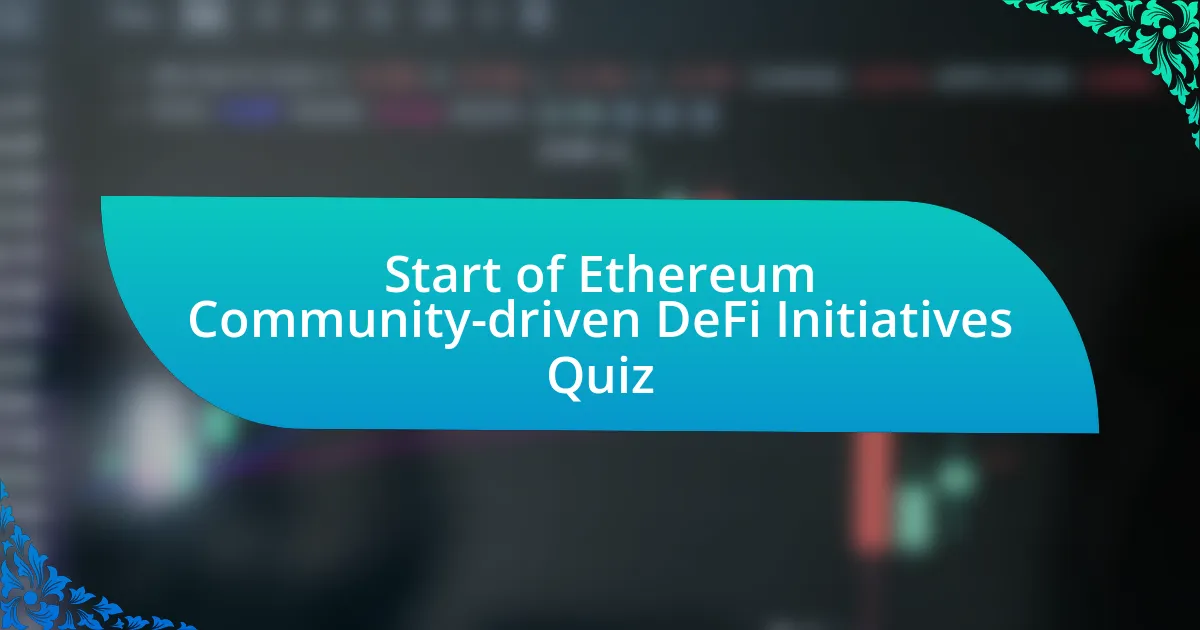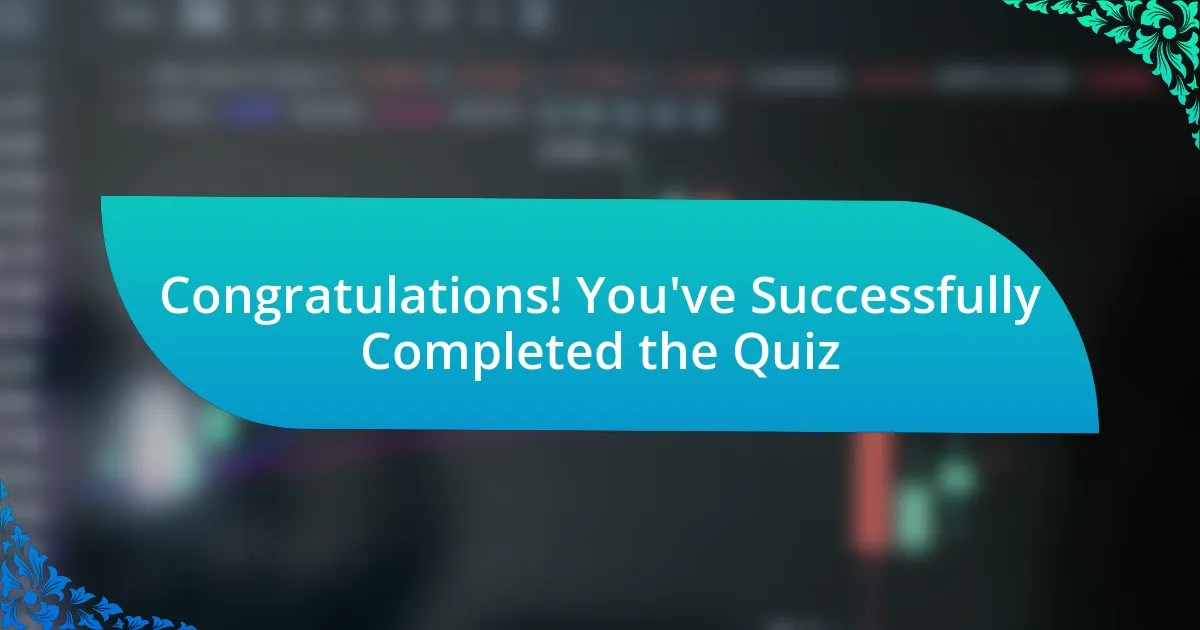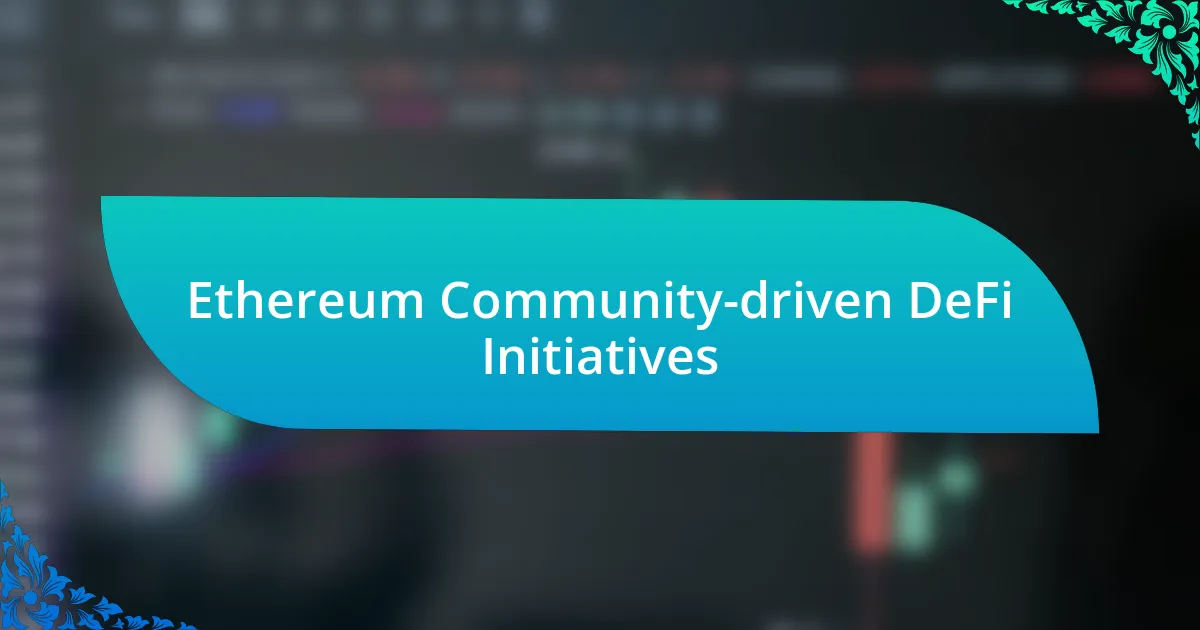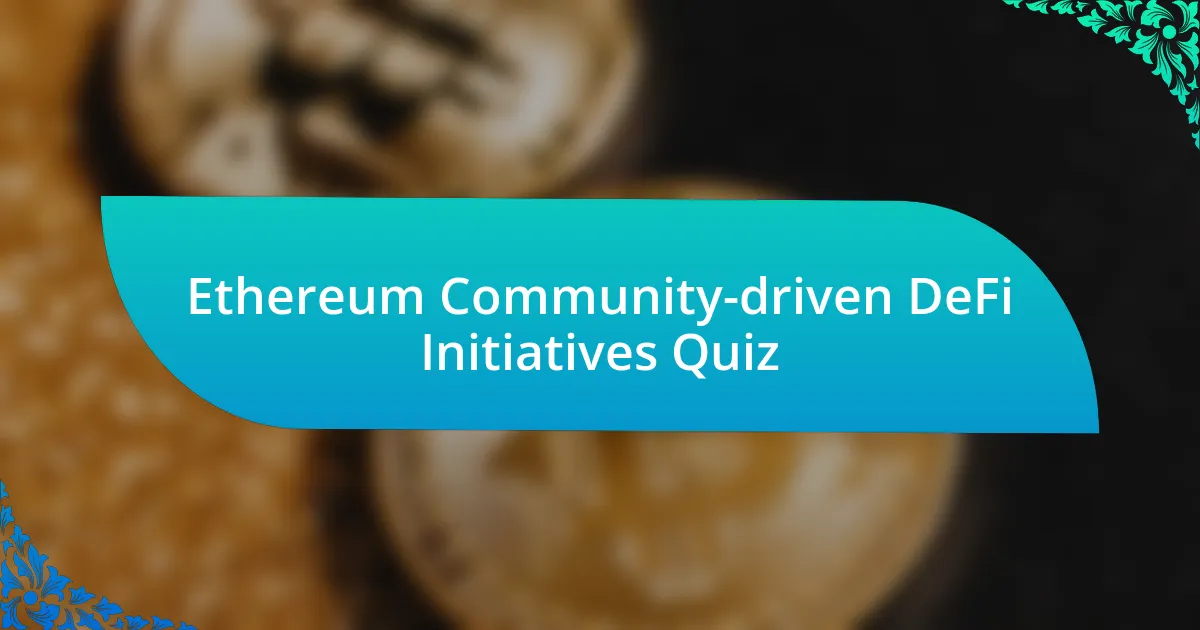
Start of Ethereum Community-driven DeFi Initiatives Quiz
1. What is the main goal of DeFi initiatives within the Ethereum ecosystem?
- To limit access to capital.
- To centralize financial control.
- To increase transaction fees.
- To create trustless financial services.
2. Name a financial product commonly transformed by DeFi on Ethereum.
- Stocks
- Lending
- Bonds
- Derivatives
3. How many distinct DeFi projects have been recorded on Ethereum to date?
- 200 DeFi projects are built on Ethereum.
- 120 DeFi projects are built on Ethereum.
- 300 DeFi projects are built on Ethereum.
- 160 DeFi projects are built on Ethereum.
4. What is the function of governance tokens in decentralized finance?
- Governance tokens allow holders to vote on protocol changes and proposals.
- Governance tokens are solely used for trading within decentralized exchanges.
- Governance tokens provide users with passive income through staking rewards.
- Governance tokens are primarily meant for unlocking premium features in DeFi applications.
5. Which platforms are known for utilizing community governance in DeFi?
- Uniswap
- Coinbase
- Kraken
- Binance
6. What aspect of DeFi governance allows direct voting on proposals?
- Staking rewards
- Liquidity pools
- Governance tokens
- Yield farming
7. Describe how votes on proposals influence outcomes in DeFi governance.
- Votes influence proposals` success based on majority support from token holders.
- Votes have no impact and proposals get executed randomly.
- Votes are only for community discussions and don’t affect outcomes.
- Votes are collected but ignored in the final proposal decisions.
8. What is the initial method of distributing governance tokens?
- Governance tokens are first allocated to random users without any prior relationship to the project.
- Governance tokens are similarly distributed only among large investors and institutions.
- Governance tokens are exclusively distributed through an auction process to the public.
- Governance tokens are initially distributed to project founders, developers, investors, and early contributors/users.
9. Identify a DeFi protocol recognized for its complex governance structure.
- PancakeSwap
- Aave
- MakerDAO
- SushiSwap
10. How does transparency enhance trust in DeFi financial transactions?
- Transparency complicates DeFi, making transactions slower.
- Transparency hides transactions, creating more uncertainty.
- Transparency allows for less accountability in DeFi protocols.
- Transparency ensures every transaction is verifiable, increasing user confidence.
11. What mechanisms are in place to ensure the security of DeFi protocols?
- DeFi protocols use traditional banking systems for transaction verification and security.
- DeFi protocols are secured by cryptography, and smart contracts are immutable once deployed on the blockchain.
- DeFi protocols only depend on user passwords to ensure security and prevent fraud.
- DeFi protocols rely on centralized financial institutions for security and oversight.
12. Discuss the advantages of interconnectivity among DeFi services.
- Different protocols can interact, enabling customized financial solutions.
- It isolates projects, making them less accessible to users.
- Interconnected services increase transaction fees unnecessarily.
- Interconnectivity limits user choices to a single platform.
13. In what way does composability benefit developers in the DeFi space?
- Composability allows developers to create innovative protocols by combining existing DeFi services.
- Composability prevents the interaction of different DeFi protocols with each other.
- Composability restricts developers to using only one protocol at a time.
- Composability makes it challenging to build new services in the DeFi space.
14. Which decentralized trading platform leads the Ethereum market?
- Balancer
- Sushiswap
- PancakeSwap
- Uniswap
15. How does Uniswap facilitate token exchanges seamlessly?
- Uniswap requires users to agree on a predetermined exchange rate.
- Uniswap charges a fee for every exchange made on the platform.
- Uniswap uses protocols based on smart contracts to facilitate exchanges.
- Uniswap facilitates exchanges only between two specific tokens.
16. Explain how Compound adjusts its interest rates in response to market demand.
- The interest rate is determined by a fixed formula unrelated to market fluctuations.
- The interest rate in Compound is adjusted automatically based on supply and demand.
- The interest rate remains constant and does not change with market conditions.
- Compound sets interest rates manually each week based on user requests.
17. What governance features are notable in MakerDAO?
- MakerDAO follows traditional corporate governance structures.
- MakerDAO has specialized governance mechanisms, including a constitution.
- MakerDAO primarily operates through centralized decision-making.
- MakerDAO`s governance solely relies on a single founder`s input.
18. Describe the dissolution process of the Maker Foundation.
- The Maker Foundation dissolved but retained all MKR tokens within the foundation.
- The Maker Foundation dissolved, and all MKR tokens held in the MKR development wallet were handed over to a community wallet governed by the DAO.
- The Maker Foundation was acquired by a centralized entity, keeping all governance tokens.
- The Maker Foundation transitioned to traditional financial models, abandoning DeFi principles.
19. What advantages does composability offer in terms of innovation?
- Composability is primarily concerned with user privacy, not innovation.
- Composability restricts users to a single protocol, limiting innovation.
- Composability focuses on preserving traditional financial systems without change.
- Composability allows users to combine different DeFi services to enhance innovation.
20. How do various DeFi services collaborate within their ecosystem?
- DeFi protocols compete against each other, limiting collaboration.
- Governance tokens assign all decision-making power to a single entity.
- Services are independent and do not share resources or data.
- Different protocols can interact, creating an integrated network of services.
21. Why is security a primary advantage of using DEXs over centralized exchanges?
- DEXs enforce stricter trading limits than centralized exchanges.
- DEXs require personal information to operate effectively.
- DEXs do not hold users` funds offering greater security.
- DEXs have higher transaction fees than centralized exchanges.
22. Outline the steps involved in the governance proposal process within DeFi.
- Proposal creation, exchange of tokens, execution by founders.
- Market analysis, funding allocation, community voting.
- Discussion, voting, execution of proposals based on majority votes.
- Document drafting, private meetings, central execution.
23. How can individuals engage in the governance of DeFi projects?
- Governance participation is limited to the founding team and major investors only.
- Users can participate by holding governance tokens and voting on proposals or delegating their votes to third parties.
- Individuals can only trade tokens to influence decisions in DeFi projects.
- Users must work for the project to have a say in governance decisions.
24. What role do smart contracts play in maintaining DeFi integrity?
- Smart contracts automate transactions and enforce rules without intermediaries.
- Smart contracts eliminate the need for any coding in DeFi applications.
- Smart contracts replace traditional banking systems entirely.
- Smart contracts only serve to record blockchain events without functional application.
25. How does Compound facilitate the logistics of lending and borrowing?
- Compound uses centralized banks to manage its lending and borrowing activities.
- Compound operates by pooling funds into a single account for all users who borrow or lend.
- Compound provides a decentralized platform for lending and borrowing cryptocurrencies, allowing users to earn interest or borrow based on collateral.
- Compound requires users to provide personal information to facilitate borrowing and lending.
26. What are the operational advantages of decentralized governance in the DeFi landscape?
- Decentralized governance limits stakeholder influence, making decisions solely based on founding members.
- Decentralized governance centralizes decision-making power to a select group of investors and developers.
- Decentralized governance eliminates community input and relies on automated processes without human intervention.
- Decentralized governance enables protocols to effectively respond to change, ensuring they can continue to achieve their objectives while minimizing the work required by the community.
27. Name a unique feature of Compound`s interest rate mechanism.
- Fixed interest rates over time
- User-set interest rates only
- Interest rates determined by a central authority
- Automatically adjusts based on supply and demand
28. How does MakerDAO’s governance reflect ongoing evolution?
- MakerDAO`s governance process has evolved through community participation and infrastructure development.
- MakerDAO`s governance has not changed since its inception and remains unchanged.
- MakerDAO`s governance relies solely on a single leader making all decisions.
- MakerDAO`s governance process is fixed with no user input or changes.
29. Discuss the concept of immutability in relation to DeFi contracts.
- Smart contracts in DeFi are mutable, allowing constant changes and updates.
- Smart contracts in DeFi can be easily modified by developers at any time after deployment.
- Smart contracts in DeFi are immutable once deployed on the blockchain, ensuring that once a contract is set up, it cannot be altered.
- Immutability in DeFi means that contracts can be deleted if they contain errors.
30. How do DeFi protocols mitigate the risks associated with cybersecurity?
- DeFi protocols rely solely on centralized security measures to prevent attacks.
- DeFi protocols ignore cybersecurity risks by assuming they are not a concern.
- DeFi protocols switch to traditional banking systems to handle risks effectively.
- DeFi protocols use cryptography and immutable contracts to minimize risks.

Congratulations! You’ve Successfully Completed the Quiz
Thank you for participating in the quiz on Ethereum community-driven DeFi initiatives. We hope you enjoyed the experience as much as we did. Engaging with content like this is crucial for understanding the evolving landscape of decentralized finance. You may have discovered key concepts, various projects, and the unique role that the community plays in shaping DeFi.
As you reflect on your answers, consider how these initiatives influence financial systems and empower users. The knowledge gained from this quiz can deepen your understanding of how Ethereum operates within the broader financial ecosystem. Whether you learned about governance models, popular DeFi applications, or innovative solutions, there’s much to consider and explore further.
To expand your knowledge even more, we invite you to delve into the next section on our page dedicated to Ethereum community-driven DeFi initiatives. Here, you’ll find a wealth of information designed to enhance your understanding and keep you updated on this dynamic subject. Happy learning!

Ethereum Community-driven DeFi Initiatives
Understanding Ethereum and Its Role in DeFi
Ethereum is a decentralized blockchain platform that facilitates smart contracts and decentralized applications (dApps). It plays a pivotal role in the decentralized finance (DeFi) ecosystem by allowing developers to create financial services without intermediaries. This leads to reduced costs and increased accessibility. The Ethereum blockchain’s programmability enables various financial products and services, making it a cornerstone for DeFi initiatives.
The Importance of Community in Ethereum DeFi Initiatives
The Ethereum ecosystem thrives on community involvement. Community-driven initiatives foster innovation and ensure that projects align with user needs. This collaborative approach encompasses governance models such as decentralized autonomous organizations (DAOs), where stakeholders can influence the project’s direction. Active community participation often leads to improved project transparency and enhanced user trust.
Popular Community-Driven DeFi Projects on Ethereum
Several notable community-driven projects have emerged within the Ethereum DeFi landscape. Protocols like Uniswap and Aave exemplify this trend. Uniswap enables users to trade tokens directly from their wallets, utilizing an automated market maker model. Aave is a lending platform that allows users to lend and borrow cryptocurrencies with variable interest rates, emphasizing community governance through token holders.
The Role of Governance Tokens in Ethereum DeFi
Governance tokens empower communities to participate in decision-making processes. In Ethereum DeFi, tokens such as UNI (Uniswap) and AAVE (Aave) provide holders with voting rights on protocol changes and developments. This decentralized governance model encourages active participation and aligns the interests of users with the long-term health of the project. It ensures that changes reflect the community’s needs and priorities.
Challenges Faced by Community-Driven DeFi Initiatives
Community-driven DeFi initiatives encounter several challenges. Governance can become contentious as differing opinions emerge among token holders. Security vulnerabilities, such as hacks and exploits, pose risks that may undermine trust. Regulatory uncertainties also impact these initiatives, as legislation evolves. These challenges require ongoing community engagement and robust security measures to sustain growth and confidence in the ecosystem.
What are Ethereum community-driven DeFi initiatives?
Ethereum community-driven DeFi initiatives are decentralized finance projects and protocols built on the Ethereum blockchain, developed to enhance financial services through community collaboration. They include lending platforms, decentralized exchanges, and yield farming protocols like Aave and Uniswap. These initiatives empower users to engage in transactions without intermediaries, thereby fostering financial inclusivity.
How do Ethereum community-driven DeFi initiatives function?
Ethereum community-driven DeFi initiatives function through smart contracts, which automate the execution of financial transactions. Users interact directly with decentralized applications (dApps) via their crypto wallets. This process reduces reliance on traditional financial institutions, enabling seamless asset swaps, automated market-making, and liquidity provision. The security and transparency of transactions are ensured through the underlying Ethereum blockchain.
Where can one find Ethereum community-driven DeFi initiatives?
One can find Ethereum community-driven DeFi initiatives on various decentralized finance aggregators and platforms such as DeFi Pulse, CoinGecko, and DappRadar. These platforms list active projects, their total value locked (TVL), and performance metrics. Additionally, the Ethereum ecosystem hosts numerous dApps accessible via Ethereum wallets and decentralized exchanges.
When did Ethereum community-driven DeFi initiatives gain significant popularity?
Ethereum community-driven DeFi initiatives gained significant popularity in 2020, known as the “DeFi Summer.” During this period, projects like Compound and Yearn.Finance experienced explosive growth, with total value locked in DeFi protocols surpassing $9 billion by the end of the year. This surge was driven by increased user participation and innovation in decentralized lending and yield farming.
Who are the primary contributors to Ethereum community-driven DeFi initiatives?
The primary contributors to Ethereum community-driven DeFi initiatives include independent developers, established blockchain companies, and community members who propose enhancements through governance tokens. These contributors collectively work to improve protocols, develop new features, and ensure community alignment with project goals. Notable influencers in this space include Vitalik Buterin and prominent DeFi project founders.

